I had intended my recent discourse on art and life as represented by the Biennale to be my only comment. There are so many other outlandish things which deserve to be brought forward for class discussion.
But a wander down via Garibaldi showed that there is an innocent, unoffending part of the neighborhood which has been artified by means of the incantatory power of the by-now impenetrable language of art. A newcomer identified as “Scatiggio” has chosen to chance his arm by decorating some store windows with brief descriptions of their merchants as artists and/or the merchandise as art.
This doesn’t mean that the thing described is art, but that it is intended to be regarded as art due to its (hopefully) convincing description. There is a case to be made that naming something gives it reality, but this isn’t the time or place to make it.
As a lover of language, and a huge fan of intelligent and original thought, all this seriously slowed me down on my way home from the post office.
I present for your consideration a few examples of this, um, art. And by the way, do not suppose that my disparagement of these shenanigans is due to ignorance. It seems to be a human tendency to ascribe power to inanimate objects — a case could be made for comparing tree-worship to calling pet-store wares “art.” Smart people for centuries believed that the drug-induced ravings of probably vitamin-deficient women, or the incoherent monologues of the mentally ill, were the utterances of gods. Otherwise well-balanced people have always been easy to seduce by the extraordinary assertions of snake-oil or diet-pill salesmen, and to believe all sorts of hoaxes ranging from the Fiji mermaid to dihydrogen monoxide.
People are susceptible in part because they believe that words mean something. Peasants! In the case of Scatiggio we have someone for whom English is not his first language using language to convince us that everyday commodities are art. This is by now a given in the world of art — nothing new here. But if, as the window of the tobacco-shop states, there might not be any boundaries dividing art and reality, it’s even clearer that the boundaries that keep language and thought in their proper relationship have become unreliable. Wow. Just when you thought things couldn’t get worse.
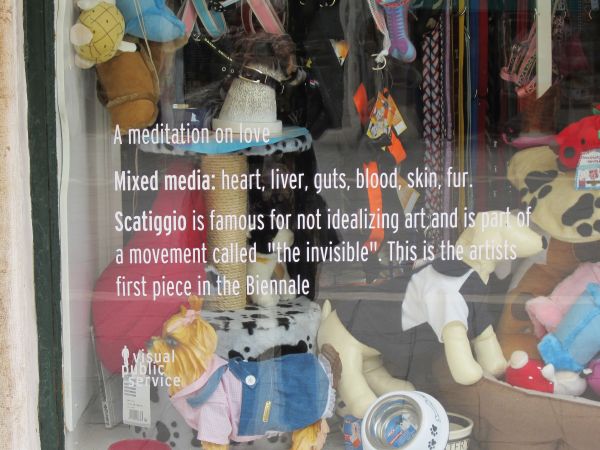
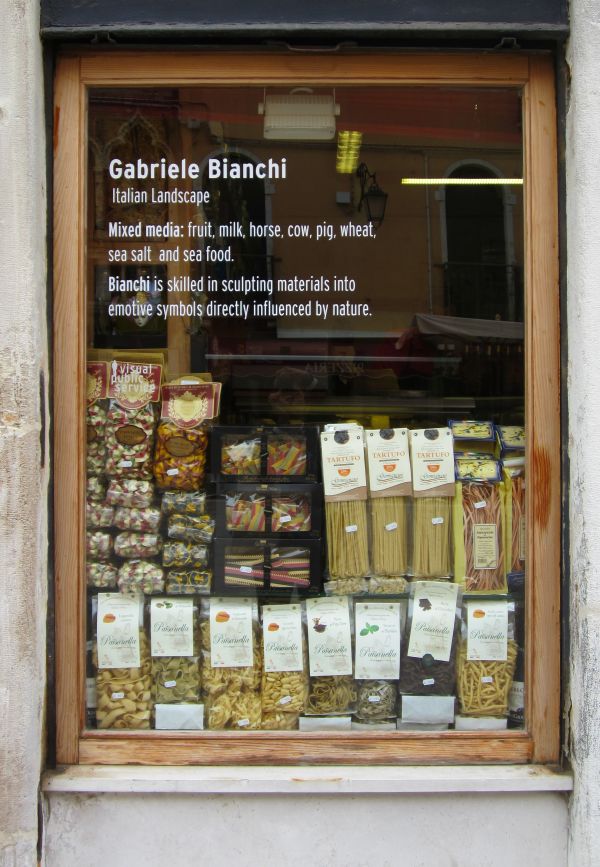
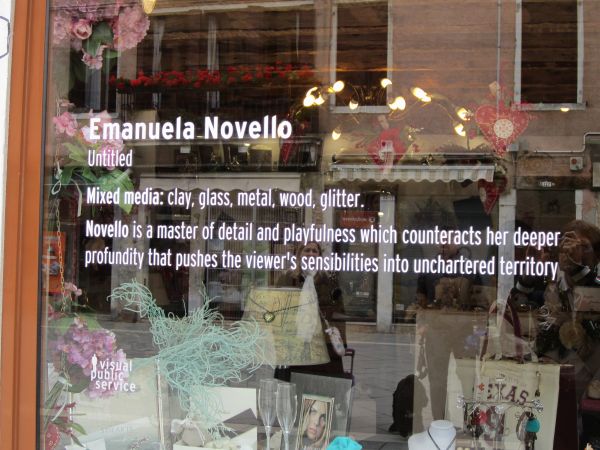
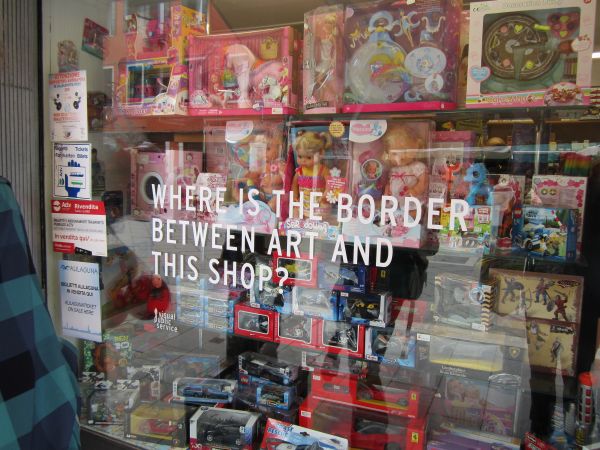
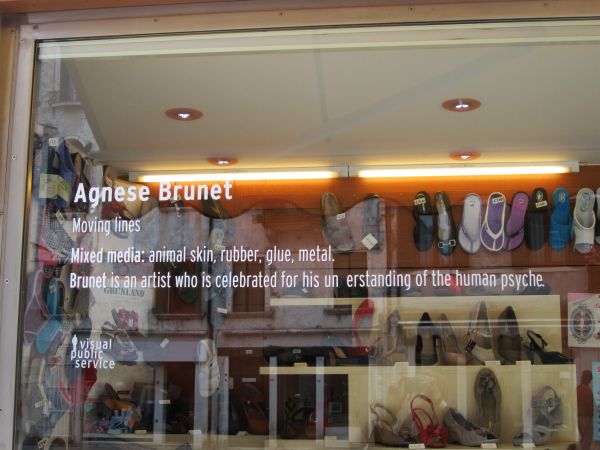

This isn’t such a hard game to play. Here are some of my own efforts, and I donate them to the stores that Scatiggio missed, or ignored. There are loads more, but while art may be long, life is short.
ALBERTO BATTISTEL, butcher. Mixed media: mammal muscle, blood, gristle, grease, waxed paper, steel
At the nexus of life and death, the implacability of knives and money slaughters the fate of generations.
MANUELA PITTERI, cafe owner. Mixed media: coffee, wheat, sugar, chocolate, milk
Essence of mountain soil, murdered beans of darkling aroma are resurrected in the elemental violence of water and fire, transformed from silent plant to music in humanity’s venous meanders.
E FIE, wine store. Mixed media: Grapes, water, plastic, glass
The vine submits to the fervor of fermentation, sacrificing sugar, soaking in its own lymph. How can joy and tears spring from the same tumultuous root, secret subjugation of sense and cogitation, and time relent only to destroy memory?
THE NEWSSTAND. Mixed media: cellulose, ink, vinyl, pigments, surfactants
Screaming paper, the multiple dimensions of life reduced to thin sheets of tree fiber, smeared with cruel dyes, and eager, jaws agape, for miniscule curiosity to enter its monstrous maw, consumed in the ephemeral tragedies of unceasing night and day.
Hey, this is fun. It’s even better than haiku — I don’t have to worry about grammar or meaning. It’s like playing Scrabble inventing words with whatever tiles you’ve got left. Maybe I’ll try it in Turkish next.
I’m going to stop now. I realize that I have left untilled great greenswards of fertile fields of potential: The post office, the barber, the dry cleaner, the jewelry store, the pharmacy, the cell-phone-and-computer shop, the doctor’s office….
But art has to go home now, because I’ve got to clean the bathroom and finish the ironing.

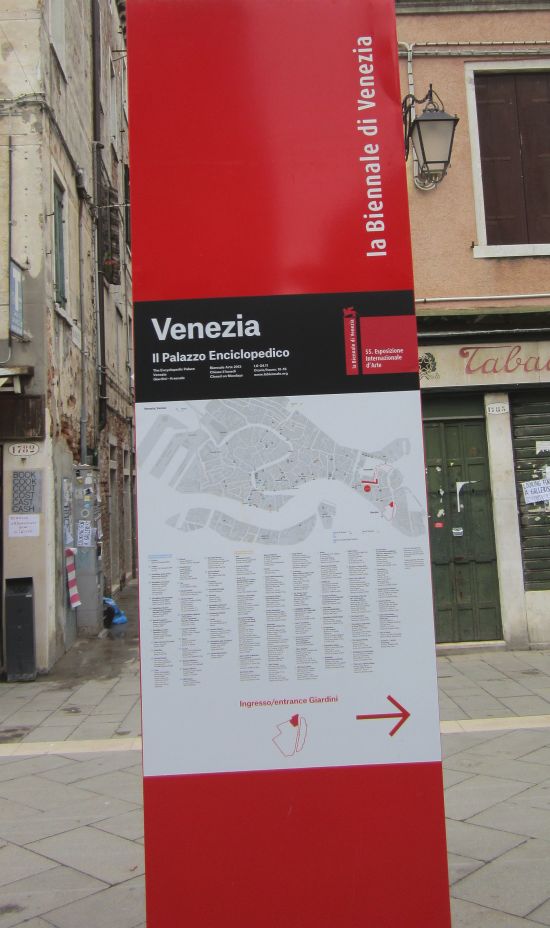
11 Comments
Really enjoyed this article. Thank you.
A great couple of posts about the Biennale. Opportunists unite!
TOUCHÉ (Again.)
Your shop labels are way better than Scataggio’s.
Reminds me of the description of the Boy with the Frog, which I read a few years ago. That one was an entire page long though 🙂
Hi Erla, I have long been an admirer of your acerbic and hilarious blog. I have only been fortunate enough to spend 5 days in Venice a decade ago, sigh, – fulfillment of a lifetime’s ambition and it was a truly memorable experience. Above all the thing that impressed me most were the Venetians doing their daily life despite all that they are beset with as chronicled so well here. I live in Australia and the Aussies have a great sense of humour and would immediately recognise these windows as someone “taking the piss” – probably an untranslatable term but very close to “having a lend” of you or “pulling your leg” or similar – very “tongue in cheek”. I think the window statements are hilarious and good on whoever did it.
Appreciation always appreciated — as you know, it’s in very short supply in this world, so thanks. I’m aware of the expression “taking the piss” out of someone or -thing, and while it’s fun to do, I have to be careful because sometimes around here it’s like shooting trout in a fishfarm pond. I’m glad you have good memories of Venice. That’s important to me.
I see Visual Public Service has a Facebook page, and they are apparently projecting some of these phrases on building facades in the wee hours.
But I concur that Erla’s are better. Particularly the sfuso one.
I see it as a spoof on installations. They fill a room with crap, then describe its contents similar to the way they are described on these shops, and then put together a bunch of artspeak meant to convince (or to hypnotize) the rube that they are looking at art, which is no more art than a shop full of cheese and pasta.
Just read the one for Emanuella’s shop. “Deeper profundities . . .” It’s bloody gibberish, as is nearly all descriptions of art to be found at the Biennale.
If it’s a spoof, they’ve done it very well. But the thing about the Biennale is that it takes itself so seriously that you can’t even be sure if something is a joke. I mean, if something is intended to be a joke.
The best you can hope for is that Scatiggio is, indeed, taking the mickey out of art criticism. But, as with emails, sarcasm and irony need a smiley face emoticon so you can be sure.